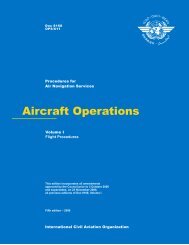Operation of Aircraft
Annex 6, Part I
Annex 6, Part I
- No tags were found...
Create successful ePaper yourself
Turn your PDF publications into a flip-book with our unique Google optimized e-Paper software.
Annex 6 — <strong>Operation</strong> <strong>of</strong> <strong>Aircraft</strong><br />
8) density <strong>of</strong> water (seaplanes);<br />
9) strength <strong>of</strong> current (seaplanes).<br />
2.1.2 The methods <strong>of</strong> correcting the performance data to<br />
obtain data for adverse atmospheric conditions include<br />
appropriate allowance for any increased airspeeds and cowl<br />
flap or radiator shutter openings necessary under such<br />
conditions to maintain engine temperatures within appropriate<br />
limits.<br />
2.1.3 For seaplanes appropriate interpretations <strong>of</strong> the term<br />
landing gear, etc., are made to provide for the operation <strong>of</strong><br />
retractable floats, if employed.<br />
2.2 Take-<strong>of</strong>f safety speed<br />
2.2.1 The take-<strong>of</strong>f safety speed is an airspeed (CAS) so<br />
selected that it is not less than:<br />
a) 1.20V S 1<br />
, for aeroplanes with two power-units;<br />
b) 1.15V S 1<br />
, for aeroplanes having more than two powerunits;<br />
c) 1.10 times the minimum control speed, V MC established<br />
as prescribed in 2.3;<br />
where V S 1<br />
is appropriate to the configuration, as described in<br />
2.3.1 b), c) and d).<br />
2.3 Minimum control speed<br />
2.3.1 The minimum control speed, V MC , is determined<br />
not to exceed a speed equal to 1.2V S 1 , where V S1 corresponds<br />
with the maximum certificated take-<strong>of</strong>f mass with:<br />
a) maximum take-<strong>of</strong>f power on all power-units;<br />
b) landing gear retracted;<br />
c) wing flaps in take-<strong>of</strong>f position;<br />
d) cowl flaps and radiator shutters in the position<br />
recommended for normal use during take-<strong>of</strong>f;<br />
e) aeroplane trimmed for take-<strong>of</strong>f;<br />
f) aeroplane airborne and ground effect negligible.<br />
2.3.2 The minimum control speed is such that, when any<br />
one power-unit is made inoperative at that speed, it is possible<br />
to recover control <strong>of</strong> the aeroplane with the one power-unit<br />
still inoperative and to maintain the aeroplane in straight flight<br />
at that speed either with zero yaw or with a bank not in excess<br />
<strong>of</strong> 5 degrees.<br />
Part I<br />
2.3.3 From the time at which the power-unit is made<br />
inoperative to the time at which recovery is complete,<br />
exceptional skill, alertness, or strength on the part <strong>of</strong> the pilot<br />
is not required to prevent any loss <strong>of</strong> altitude other than that<br />
implicit in the loss <strong>of</strong> performance or any change <strong>of</strong> heading<br />
in excess <strong>of</strong> 20 degrees, nor does the aeroplane assume any<br />
dangerous attitude.<br />
2.3.4 It is demonstrated that to maintain the aeroplane in<br />
steady straight flight at this speed after recovery and before<br />
retrimming does not require a rudder control force exceeding<br />
800 N and does not make it necessary for the flight crew to<br />
reduce the power <strong>of</strong> the remaining power-units.<br />
2.4 Critical point<br />
2.4.1 The critical point is a selected point at which, for<br />
the purpose <strong>of</strong> determining the accelerate-stop distance and the<br />
take-<strong>of</strong>f path, failure <strong>of</strong> the critical power-unit is assumed to<br />
occur. The pilot is provided with a ready and reliable means <strong>of</strong><br />
determining when the critical point has been reached.<br />
2.4.2 If the critical point is located so that the airspeed at<br />
that point is less than the take-<strong>of</strong>f safety speed, it is demonstrated<br />
that, in the event <strong>of</strong> sudden failure <strong>of</strong> the critical powerunit<br />
at all speeds down to the lowest speed corresponding with<br />
the critical point, the aeroplane is controllable satisfactorily and<br />
that the take-<strong>of</strong>f can be continued safely, using normal piloting<br />
skill, without reducing the thrust <strong>of</strong> the remaining power-units.<br />
2.5 Accelerate-stop distance required<br />
2.5.1 The accelerate-stop distance required is the distance<br />
required to reach the critical point from a standing start and,<br />
assuming the critical power-unit to fail suddenly at this point,<br />
to stop if a landplane, or to bring the aeroplane to a speed <strong>of</strong><br />
approximately 6 km/h (3 kt) if a seaplane.<br />
2.5.2 Use <strong>of</strong> braking means in addition to, or in lieu <strong>of</strong>,<br />
wheel brakes is permitted in determining this distance,<br />
provided that they are reliable and that the manner <strong>of</strong> their<br />
employment is such that consistent results can be expected<br />
under normal conditions <strong>of</strong> operation, and provided that<br />
exceptional skill is not required to control the aeroplane.<br />
2.5.3 The landing gear remains extended throughout this<br />
distance.<br />
2.6.1 General<br />
2.6 Take-<strong>of</strong>f path<br />
2.6.1.1 The take-<strong>of</strong>f path is determined either by the<br />
method <strong>of</strong> elements, 2.6.2, or by the continuous method, 2.6.3,<br />
or by any acceptable combination <strong>of</strong> the two.<br />
1/11/01 ATT C-6












